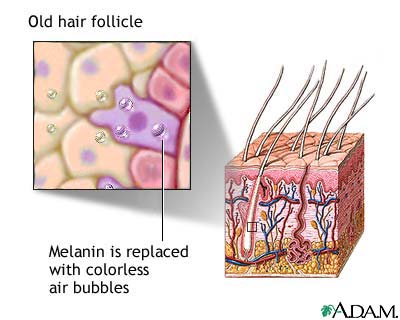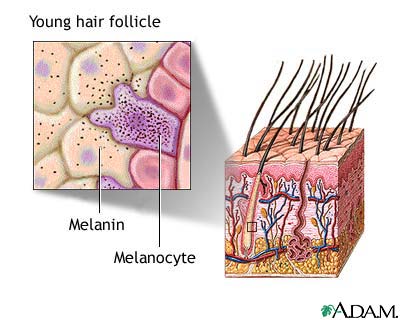Why Does Hair Turn Gray?

Introduction
It is well known that gray hair results from a reduction of pigment, while white hair has no pigment, but why this happens remains somewhat of a mystery.
Parents often cite having teenagers as the cause of gray hair. This is a good theory, but scientists continue to investigate why hair turns gray. In time, everyone's hair turns gray. Your chance of going gray growths 10-20% every decade after 30 years.
People can get gray hair at any age. Some people go gray at a young age - as early as when they are in high school or college -whereas others may be in their 30s or 40s.
How early we get gray hair is determined by our genes. This means that most of us will start having gray hairs around the same age that our parents or grandparents first did.
In 2009, scientists in Europe described how hair follicles produce small amounts of hydrogen peroxide. This chemical builds on the hair shafts, which can lead to a gradual loss of hair color.

Initially, hair is white. It gets its natural color from a type of pigment called melanin. The formation of melanin begins before birth. The natural color of our hair depends upon the distribution, type and amount of melanin in the middle layer of the hair shaft or cortex.
Hair has only two types of pigments: dark (eumelanin) and light (phaeomelanin). They blend together to make up the wide range of hair colors.
Melanin is made up of specialized pigment cells called melanocytes. They position themselves at the openings on the skin's surface through which hair grows (follicles). Each hair grows from a single follicle.
Hair color is the pigmentation of hair follicles due to two types of melanin, eumelanin and pheomelanin. Generally, if more melanin is present, the color of the hair is darker; if less melanin is present, the hair is lighter.
Hair follicle of young person - Hair color is caused by a pigment (melanin) that is produced by the hair follicle. With aging, the follicle produces less melani

The process of hair growth has three phases:
- Anagen: This is the active growth stage of the hair fiber and can last from 2- 7 years. At any given moment 80-85% of our hair is in the anagen phase.
- Catagen: Sometimes referred to as the transitional phase, which is when hair growth begins to "shut down" and stop activity. It generally lasts 10- 20 days.
- Telogen: This occurs when hair growth is completely at rest and the hair fiber falls out. At any given time, 10-15 % of our hair is in the telogen phase, which generally lasts 100 days for scalp hair. After the telogen phase, the hair growth process starts over again to the anagen phase.
As the hair is being formed, melanocytes inject pigment (melanin) into cells containing keratin. Keratin is the protein that makes up our hair, skin, and nails. Throughout the years, melanocyctes continue to inject pigment into the hair's keratin, giving it a colorful hue. With age comes a reduction of melanin. The hair turns gray and eventually white.
Hair has the highest rate of mitosis (cell division). An average hair grows 0.3 mm a day and 1 cm per month.
Human hair grows autonomously, that is each hair is on its own individual cycle. If all our hair were on the same cycle, we would molt!
Hair is so strong that each hair can withstand the strain of 100 grams (3.5 ounces). An average head of hair could hold 10-15 tons if only the scalp was strong enough!
An average scalp has 100,000-150,000 hairs.

So why does our hair turn gray or white?
Dr. Desmond Tobin, professor of cell biology from the University of Bradford in England, suggests that the hair follicle has a "melanogentic clock" which slows down or stops melanocyte activity, thus decreasing the pigment our hair receives. This occurs just before the hair is preparing to fall out or shed, so the roots always look pale.
Moreover, Dr. Tobin suggests that hair turns gray because of age and genetics, in that genes regulate the exhaustion of the pigmentary potential of each individual hair follicle. This occurs at different rates in different hair follicles. For some people it occurs rapidly, while in others it occurs slowly over several decades.
In a February 2005 Science article (Nishimura, et al.) Harvard scientists proposed that a failure of melanocyte stem cells (MSC) to maintain the production of melanocytes could cause the graying of hair. This failure of MSC maintenance may result in the breakdown of signals that produce hair color.
There are other factors that can change the pigmentation of hair, making it lighter or darker. Scientists have divided them by intrinsic (internal) and extrinsic (external) factors:
Intrinsic factors:
- Genetic defects
- Hormones
- Body distribution
- Age
Extrinsic factors:
- Climate
- Pollutants
- Toxins
- Chemical exposure










